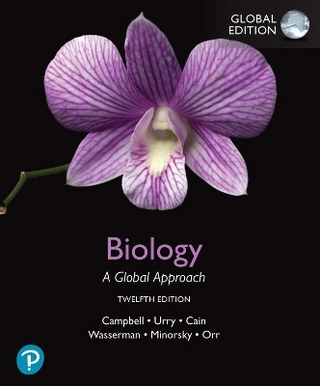
Dynamics of the Bacterial Chromosome – Structure and Function
Wiley-VCH Verlag GmbH (Hersteller)
978-3-527-60849-2 (ISBN)
- Keine Verlagsinformationen verfügbar
- Artikel merken
This book provides an unique overview on bacterial genetics, bacterial genome projects and gene technology and its applications in biological and biomedical research and medicine. The author guides the reader up the front in research within the different fields of bacterial genetics, based mainly on results received with Escherichia coli and Bacillus subtilis.
Born in 1945 in Burgellern, Germany, Wolfgang Schumann studied biology at the Johannes-Gutenberg-University of Mainz, gaining his diploma in 1970 and his PhD two years later. Following a postdoc at the Institute of Microbiology of the University of Goettingen, he became Assistant Professor at the Faculty of Biology of the University of Konstanz in 1975. From 1983 to 1986 he led a research group at the Institute of Biochemistry of the Technical Highschool of Darmstadt, before moving to the University of Bayreuth, where he was appointed Full Professor at the Faculty of Biology. Professor Schumann is on the editorial board of two journals and visiting professor at the universities of Sao Paulo and Belo Horizonte, Brazil, as well as the National University of Ho-Chi-Minh City, Vietnam.
Foreword.Bacterial Species and their Abbreviation.Color Plates.1 Structure of the Bacterial Cell.1.1 The Cytoplasm Compartment.1.2 The Cytoplasmic Membrane Compartment.1.3 The Cell Wall Compartment.1.4 The Outer Membrane Compartment.1.5 The Periplasmic Compartment.1.6 Extracellular Matrices.1.7 Appendages.2 Organization of the Bacterial Chromosome.2.1 Structure of the Chromosomes.2.2 Principles to Compact the Bacterial Chromosome.2.2.1 Superhelicity.2.2.2 Histone-like Proteins in E. coli.2.3 Organization of the Bacterial Chromosome into Genes and Repetitive Sequences.2.3.1 Genes.2.3.2 Repetitive Sequences.2.4 Large Rearrangements Within the Chromosome.2.4.1 Duplications.2.4.2 Deletions.2.4.3 Inversions.3 The Bacterial Cell Cycle: Replication of the Chromosome, Partitioning and Cell Division.3.1 Replication.3.1.1 Replication of Circular Chromosomes.3.1.2 Replication of Linear Chromosomes and Plasmids.3.2 Partitioning (Segregation) of the Daughter Chromosomes.3.3 Cell Division.3.4 Plasmid- and Chromosome-encoded Toxin Antitoxin Modules.3.4.1 Postsegregational Killing of Plasmid-free Cells.3.4.2 Chromosomal Toxin Antitoxins.4 Recombination.4.1 Homologous Recombination.4.1.1 The RecBCD Pathway of Homologous Recombination.4.1.2 The RecF Pathway of Homologous Recombination.4.1.3 Additional Homologous Recombination Functions.4.1.4 Recovery of Replication at a Blocking DNA Lesion.4.2 Sequence-specific Recombination.4.2.1 Integration/Excision Systems.4.2.2 Resolvase Systems.4.2.3 Inversion Systems.4.2.4 Shufflons.4.2.5 Integrons.4.2.6 Homing Endonucleases.4.3 Illegitimate Recombination.4.3.1 Insertion Sequence Elements.4.3.2 Transposons.4.3.3 Transposing Bacteriophages.4.3.4 Mechanisms of Transposition.4.3.5 Conjugative and Integrative Elements.4.3.6 Nonhomologous Endjoining (NHEJ).5 Origin of Mutations and Repair of DNA Lesions.5.1 Classes of Mutations.5.2 Origin of Mutations.5.2.1 Spontaneous Mutations.5.2.2 Induced Mutations.5.2.3 Detection Systems for Mutations.5.2.4 Adaptive Mutations.5.3 Repair of DNA Lesions.5.3.1 The Methyl-mediated Mismatch Repair System.5.3.2 Very Short Patch Repair.5.3.3 The Nucleotide Excision Repair Systems.5.3.4 Pathways of Base Excision Repair.5.3.5 Repair of Oxidized Nucleotides.5.3.6 Photoreactivation of Cyclobutane Dimers.5.3.7 Transcription-coupled Nucleotide Excision Repair.5.3.8 The Adaptive Response.5.3.9 The SOS Response.5.3.10 Replication and Repair.5.3.11 Repair of Interstrand Crosslinks in DNA.5.3.12 Deinococcus radiodurans.6 Principles of Gene Regulation.6.1 Regulation at the Level of DNA.6.1.1 Alterations of the Structure of the DNA.6.1.2 GATC Methylation and Gene Expression.6.1.3 Programmed DNA Rearrangements Within the Chromosome.6.1.4 Transcriptional Silencing and Cryptic Genes.6.2 Regulation at the Level of Transcription.6.2.1 The DNA-dependent RNA Polymerase.6.2.2 Regions of the Promoter.6.2.3 Initiation of Transcription.6.2.4 Elongation of Transcription.6.2.5 Termination of Transcription.6.2.6 Anti-sigma Factors.6.2.7 Anti-termination/Attenuation of Transcription.6.2.8 Regulators of the DNA-dependent RNA Polymerase.6.3 Post-transcriptional Regulation.6.3.1 Protein-mediated Regulation.6.3.2 Riboregulation.6.3.3 Riboswitches.6.3.4 mRNA Decay.6.3.5 Introns.6.3.6 RNA-binding Proteins.6.4 Regulation at the Level of Translation.6.4.1 Initiation of Translation.6.4.2 Elongation of Translation.6.4.3 Termination of Translation.6.4.4 Ribosome Recycling.6.4.5 Translational Control.6.4.6 The 21. and 22. Amino Acid Selenocysteine and Pyrrolysine.6.4.7 Mechanisms to Create Multiple Gene Products From a Single Cistron.6.5 Post-translational Regulation.6.5.1 Proteolysis.6.5.2 Protein Splicing.6.5.3 Protein Glycosylation.6.5.4 Circular Polypeptides.7 Protein Quality Control Through Molecular Chaperones, Protein Folding Catalysts and ATP-dependent Proteases.7.1 Introduction.7.2 Molecular Chaperones.7.2.1 Folder Chaperones.7.2.2 Holder Chaperones.7.2.3 Disaggregating Chaperones.7.2.4 Intramolecular Chaperones.7.2.5 Folding of Nascent Polypeptide Chains.7.3 Protein-folding Catalysts.7.3.1 Peptidyl-prolyl Isomerases.7.4 Disulfide Bond Formation.7.5 Proteases.7.5.1 ATP-dependent Proteases.7.5.2 ATP-independent Proteases.8 Secretion of Proteins.8.1 Introduction.8.2 Protein Sorting Signals for Subcellular Localization.8.3 Cytosolic Targeting Factors.8.4 Translocases Move Newly Made Proteins Into or Across Membranes.8.4.1 The Sec Pathway of Protein Translocation Through the Inner Membrane.8.4.2 The Tat Pathway of Secretion Proteins Through the Inner Membrane.8.4.3 Insertion Proteins Into the Inner Membrane.8.5 Anchoring of Lipoproteins Into the Outer Membrane.8.6 Protein Translocation Pathways Through Both Membranes of Gram-negative Bacteria.8.6.1 The Type I Secretion Pathway.8.6.2 The Type II Secretion Pathway.8.6.3 The Type III Secretion Pathway.8.6.4 The Type IV Secretion Pathway.8.6.5 Type V Secretion Pathway (Autotransporter).8.6.6 Vesicle-mediated Export.8.7 Cell Wall-anchored Surface Proteins.8.8 S-Layers.9 Stress Genes and Their Regulation.9.1 The Stress Response Pathway.9.2 The Heat Shock Response.9.3 The Cold Shock Response.9.4 The Osmotic Shock Response.9.4.1 The Hyperosmotic Shock Response.9.4.2 The Hypoosmotic Shock Response.9.5 The Oxidative Shock Response.9.5.1 The OxyR Regulon.9.5.2 The SoxRS Regulon.9.6 pH-regulated Genes.9.6.1 Acid Stress.9.6.2 Alkaline Stress.9.7 Metabolic Stress: the Stringent Response.9.8 Nutrient Limitations (Starvation Stress).9.9 Envelope Stress Response.10 Exchange of Genes: Transformation, Conjugation and Transduction.10.1 Transformation.10.1.1 Transformation of Gram-positive Bacteria.10.1.2 Transformation of Gram-negative Bacteria.10.2 Conjugation.10.2.1 Gram-negative Bacteria.10.2.2 Gram-positive Bacteria.10.2.3 Conjugative Transposons.10.3 Transduction.10.3.1 Generalized Transduction.10.3.2 Specialized Transduction.10.4 Horizontal Gene Transfer.Glossary.Subject Index.
| Verlagsort | Weinheim |
|---|---|
| Sprache | englisch |
| Gewicht | 10 g |
| Themenwelt | Naturwissenschaften ► Biologie |
| ISBN-10 | 3-527-60849-4 / 3527608494 |
| ISBN-13 | 978-3-527-60849-2 / 9783527608492 |
| Zustand | Neuware |
| Haben Sie eine Frage zum Produkt? |
aus dem Bereich

